
 |
EDUCATION |
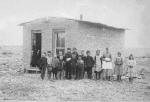 |
1880s
Schooling for the children was an
early priority. Nannie Blaine Underhill was the first teacher. The first
school, a crude cabin of upright logs, soon was replaced by a better
building of local brick. Teacher Isa Caldwell is in the doorway. She began
teaching in 1882 and taught all grades in the one room school. |
|
|
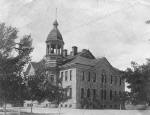 |
1890s
The Franklin Building (Grand
Junction High School) was built
in 1891 and cost $11,000. This spacious brick building with twelve rooms was
at 6th and Rood, where the current courthouse is located. First a
three year high school, it became a four year school in 1894, the year it graduated
its first four graduates. |
|
|
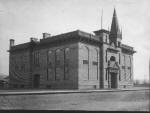 |
1900s
Originally named the Park School,
the Emerson Grade School was built at 9th and Ute in 1903. The
architect�s drawings of the large building included a dome, but it was not
included. Ninety-nine years later the building had essentially the same
appearance, minus the belfry and spire. |
|
|
|
|
 |
1920s As early as 1904 there was an attempt to establish a state college here. The idea of two year junior colleges was developing in the 1920s. Eventually the Colorado legislature and the governor agreed to an extension school of the University of Colorado. In the fall of 1925 the first college classes convened in the recently vacated Lowell School building at 5th and Rood. The nearby YMCA provided a gymnasium. Forty-one freshmen enrolled in Grand Junction State Junior College, forerunner of today�s Mesa State College. |
|
|
 |
1930s The entire town was enthused about the 1936 Grand Junction High School Tigers football team. They made widespread sports news as they played an entire season without being scored upon. The toughest game was in Salida. A special train carried fans to the meet which the Tigers won, breaking Salida�s winning streak of 39 games. The 1936 season total was Tigers 506 to 0 for their opponents. Rah Rah Tigers! (1937 Grand Junction High School Annual) |
|
|
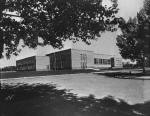 |
1940s Mesa College was ready for relocation, and 1940 saw the opening of the first building on a new campus at 12th and North. The building incorporated classrooms, auditorium/ gymnasium, administration and library. It now is named Houston Hall for Clifford Houston who was third head of the college, from 1932-1937. It has been remodeled, but the appearance is much the same. (Dean Studio Photo, Mesa State Archives, Tomlinson Library, Mesa State College) |
|
|
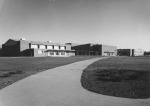 |
1950s The expanding student population of Grand Junction prompted the building of a new high school in 1955 on North 5th Street. It was designed in a clean lined, modern 1950s style by architect Paul Atchison of Denver. The auditorium was made large enough to serve also as a civic auditorium. (1958 Grand Junction High School Annual) |
|
|
 |
1960s
Mesa College
dedicated the Walter Walker Fine Arts Center on November
21, 1969. The auditorium presented the Performing Arts of music and drama.
Instruction for those fields was provided in adjacent studios and
classrooms. A nearby building had workshops, studios and kilns for the Fine
Arts of painting, drawing, sculpture, metal and ceramics. |
|
|
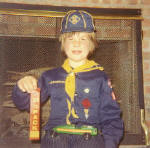 |
1970s Girl Scout and Boy Scout troops teach young people many skills which have lifelong value. Personal character, knowledge, the lore of nature, crafts and recreation are aspects of the multi faceted program. Scouting is a valuable addition to formal education. Summer and winter camps on Grand Mesa are settings for learning and recreation. (Lynn Hoffman photo) |
|
|
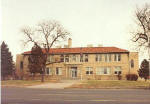 |
1980s
Not every student is geared toward
standard schools and the school district formed the alternative R-5 High
School. The curriculum offers more vocational courses and flexible hours,
and has been very successful. It is in the former Lowell School, built in
1925. Student input lead to the name R-5, which stands for Readiness,
Relevancy, Reinforcement, Responsibility and Respect. |
|
|
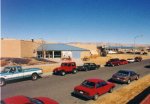 |
1990s The Tilman Bishop Unified Technical Education Center (UTEC), dedicated in 1992, was enlarged in 1996. The school, affiliated with Mesa State College and the Mesa County School District, offers vocational education in many fields. Computers, auto mechanics, hotel and restaurant management are some of the majors. Culinary students even operate a quality restaurant, open to the public at noon. (John Hedrick Photo) |
|
|
 |
2000 & Beyond Mesa State College now has more than 5,000 students. A wide range of majors are available, and several master degree programs are offered. Shown is a student at a computer terminal in Tomlinson Library. The cultural life of the city is enhanced by art shows and performing arts performances. A wide variety of sports are another contribution to community life. (John Hedrick Photo) |
|
|
|
|
If you have
arrived at this page from a search engine |
|